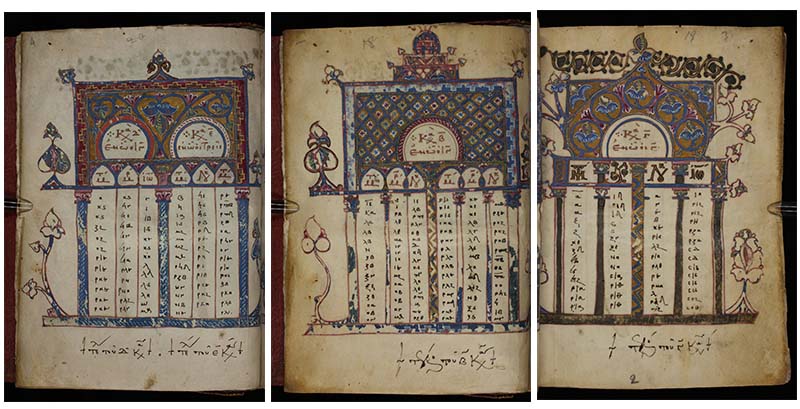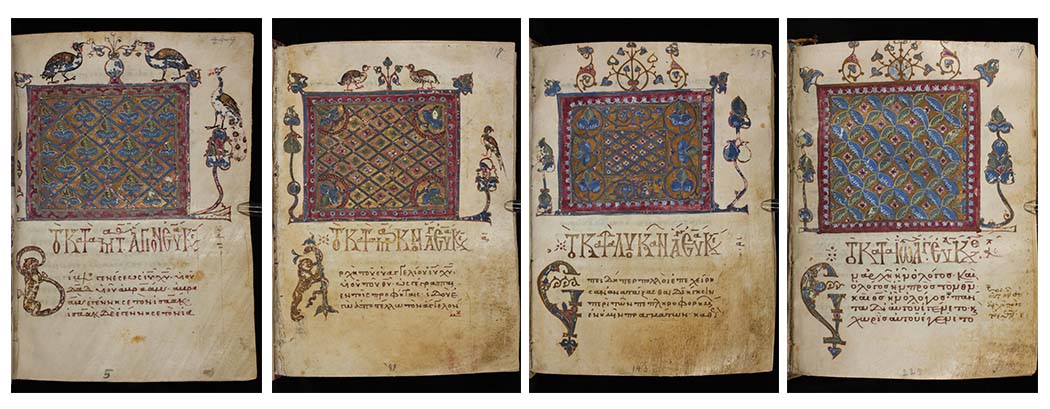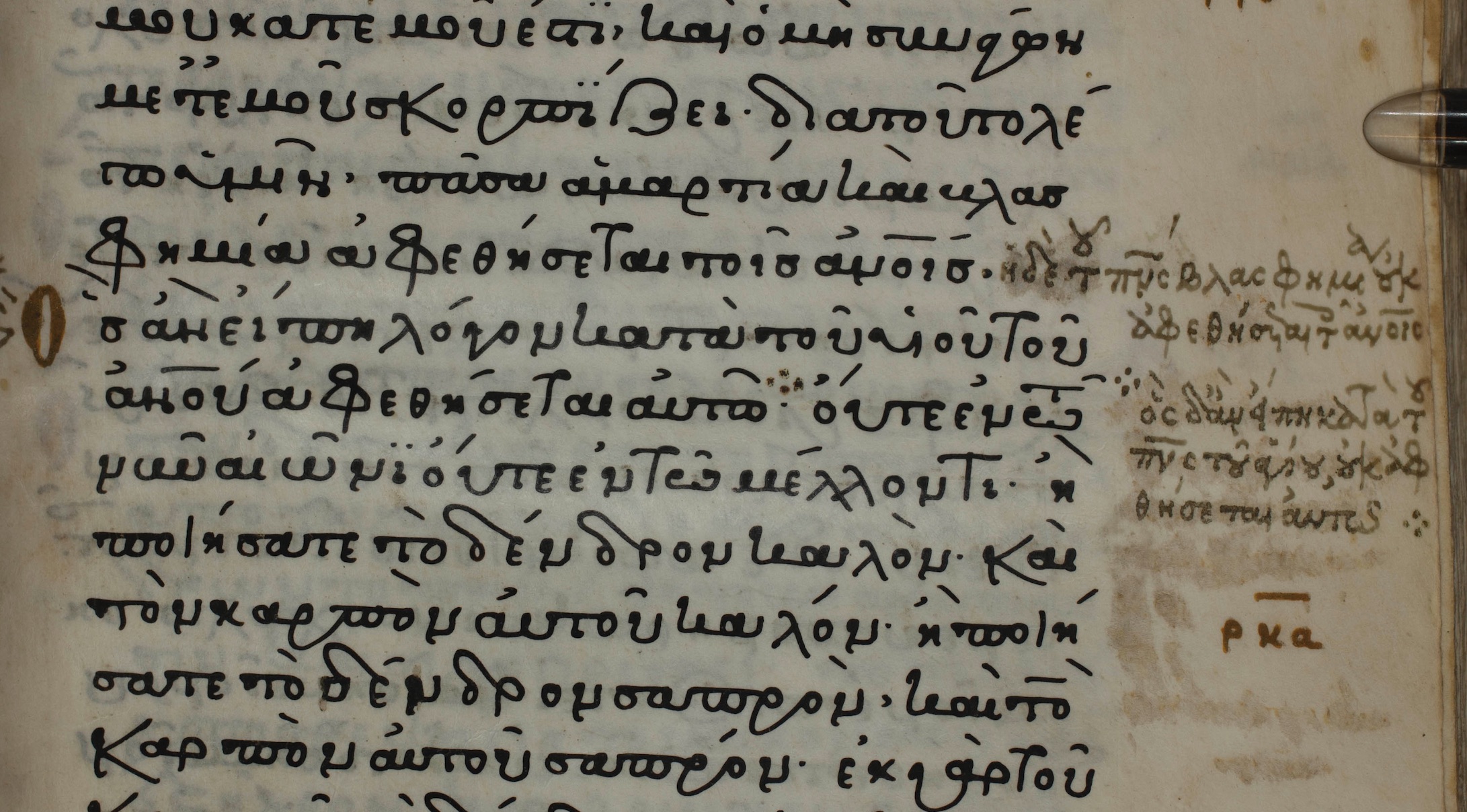The Center for the Study of New Testament Manuscripts (CSNTM) Digital Library contains hundreds of Greek NT manuscripts, each with its own story to tell. In our “From the Library” series, we will feature individual manuscripts from our collection in order to showcase their unique beauty and importance. This is part of CSNTM’s mission to make NT manuscripts accessible for everyone.
A recent addition to our collection is GA 760 from the National Library of Greece in Athens. This is a twelfth century manuscript containing all four Gospels. It is classified as a minuscule manuscript because it is written in the cursive handwriting typical of the late medieval era. The scribe who copied this manuscript had a very steady hand which can be seen in his consistent, legible handwriting.
Eusebian Canon Tables
The decorative work on the Eusebian Canon Tables in this manuscript is beautiful and ornate. A Eusebian Canon Table is a series of charts, usually found immediately before the Gospels, that note parallel passages between Matthew, Mark, Luke, and John. Then, the references located in the tables were placed in the margin next to the passage listed in the table. The canon tables played an important role in an era before the New Testament was divided into chapters and verses. These tables are usually decorated in an architectural structure, which you can see in the images from GA 760.

Eusebian Canon Tables in GA 760
Book Headpieces
Another example of the artistic work in GA 760 are the headpieces at the beginning of each gospel. The first page features a large, colorful square with a detailed pattern inside of it. This square is surrounded by decorative floral illustrations and birds, in the case of Matthew and Mark. Beneath the headpiece, the title of the book is written in large gold letters and the first line of text begins with ornate ekthesis (when the first letter is written into the left margin).
The use of gold leaf along with red, blue, and green paints, was very costly. The choice to devote significant resources to create a beautiful manuscript reflects the importance of the New Testament to the people who made and used the manuscript. Headpieces like this one are a common feature in Greek Gospels manuscripts, but the ones in GA 760 leave a particularly stunning impression on the viewer.
 The first page of Matthew, Mark, Luke, and John in GA 760
The first page of Matthew, Mark, Luke, and John in GA 760
Scribal Mishaps and Corrections
While GA 760 is an excellent example of human artistry, it is at the same time an example of human limitation and imperfection. There are several instances within the manuscript where the scribe has left out important portions of text. Another scribe then added it back in the margins when he realized the mistake! Here are a few examples of this.

Manuscript page containing corrections on Matthew 12:31–32

Manuscript page containing correction on Mark 6:37–38

Manuscript page containing correction on John 1:1–3
All of these accidental omissions resulted from situations in the biblical text where two lines end with the same word or series of words. Scribes had to look back and forth frequently between their manuscript and the exemplar (the manuscript from which they were copying the text). When they did this many times over the course of a long day, it was rather easy to skip portions of text without noticing.
For instance, the scribe accidentally skipped text twice in a row in Matthew 12:31–32. The text should read: “Therefore I tell you, every sin and blasphemy will be forgiven people, but the blasphemy against the Spirit will not be forgiven people. And whoever speaks a word against the Son of Man will be forgiven, but whoever speaks against the Holy Spirit will not be forgiven him, either in this age or in the age to come.”
However, what the scribe wrote is: “Therefore I tell you, every sin and blasphemy will be forgiven people, [skipped text: but the blasphemy against the Spirit will not be forgiven people.] And whoever speaks a word against the Son of Man will be forgiven him, [skipped text: but whoever speaks against the Holy Spirit will not be forgiven him,] either in this age or in the age to come.”
Even in English, you can see how similar the lines are. When the scribe saw the word “people” in Greek, he thought that he had finished verse 31, so he started writing verse 32. Likewise, when he saw “him” in Greek, he went on to the last part of verse 32 and continued writing. Then a corrector, writing about a century or two later, came in and added the missing (and very important!) information in the margin. The same problem occurs again in Mark 6:37–38.
Finally, perhaps the most illustrative example of the beauty and imperfection inherent within all manuscripts is the first page of John’s Gospel. The page is outstanding for its color and design, using gold ink for the beginning of the text. However, even amidst such splendor, the scribe has accidentally omitted verse 2!
The purpose of this is not to describe the scribe as sloppy or unskilled; he is not. Rather, the point is that scribes are human, just like us. Every manuscript is a human production—beautiful and broken. There is no perfect manuscript, just like there is no perfect person!
This manuscript has many other interesting features that are worth seeing, including a partially remaining icon and cruciform text (text written in the shape of a cross). To see these and the rest of the manuscript, please visit CSNTM’s Digital Library.

The study and preservation of ancient manuscripts is crucial in uncovering historical and cultural insights that shape our understanding of the past. GA 760, the Center for the Study of New Testament Manuscripts in particular, plays an instrumental role in mapping and digitizing manuscripts for wider public access. By promoting collaboration among scholars and partnering with institutions to house these ancient texts, GA 760 helps shape the field of biblical studies and expands our knowledge of early Christianity.